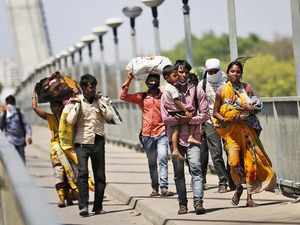
By Sanjay Kaul
The media has been full of stories and images of tens and thousands of migrant workers trying to trudge back from urban centres to their homes in villages and smaller towns. The National Sample Survey Office (NSSO) and other independent studies indicate that the percentage of causal and self-employed workers in urban areas is over 60% of the workforce.
These sections have had the immediate loss of earnings due to the Covid-19-related lockdown measures. The numbers are likely to rise, unless governments take immediate decisive steps. Many such workers may not even have Jan Dhan accounts. And even if they do, such accounts may be in their villages and they are not immediately able to access the money. As these workers — many with their families — walk home, they will traverse many villages.
Their ability to survive such long arduous journeys is itself a challenge. They also pose a health risk to themselves and to others along the way, especially those travelling from urban ‘hot spot’ Covid-19 clusters.

So, what should be done? The Delhi government has already set up centres for providing food and shelter to these hapless members of the citizenry. Other cities are also taking similar steps. But these measures are woefully inadequate. To stem the massive migration from urban to rural India we are witnessing, providing food and shelter to such families in towns and cities rendered jobless has to become a national priority.
There is need to immediately announce a countrywide scheme to provide shelter and food for all such Indians on the move during lockdown and beyond in urban towns and cities. There are two possible routes to implement this.
The first is to provide discretion to the district administration to set up shelter homes. District collectors have the requisite experience of managing relief camps at times of floods, droughts and earthquakes. Migrant workers passing through these districts must be persuaded to not go further, and be provided food and shelter then and there.
The second step would be to use voluntary organisations in a large way by providing them the requisite funds without discrimination. Classrooms in schools have often been used for providing shelter. However, they may not be the most suitable for providing large-scale shelter, as they are mostly small and social distancing norms may be difficult to enforce in such spaces.
This is the time for governments to show that they can be innovative. Why not throw open railway platforms and bus stands? If sports stadia can get converted to become isolation centres, why not such large open public spaces to be used as shelter homes?
Another easy low-hanging fruit for organising such relief measures quickly is to use temples, gurdwaras, churches, mosques and other such places of worship to get these institutions to organise food and shelter.
Funds can be transferred to their accounts without asking questions. The scale of misuse by them, if at all, should be minuscule. GoI has already announced a large package for poor and vulnerable households.
However, to tackle the situation arising out of urban joblessness, bold and decisive steps need to be taken. This alone could mitigate the economic misery of sections of India’s citizenry that have been rendered jobless. Only such actions can stem this massive flow of migration we are still witnessing. Delays would lead to huge distress, while possibly leading to the Covid-19 contagion becoming even more widespread.
(The writer is chairman, National Collateral Management Services)
Source: indiatimes.com

